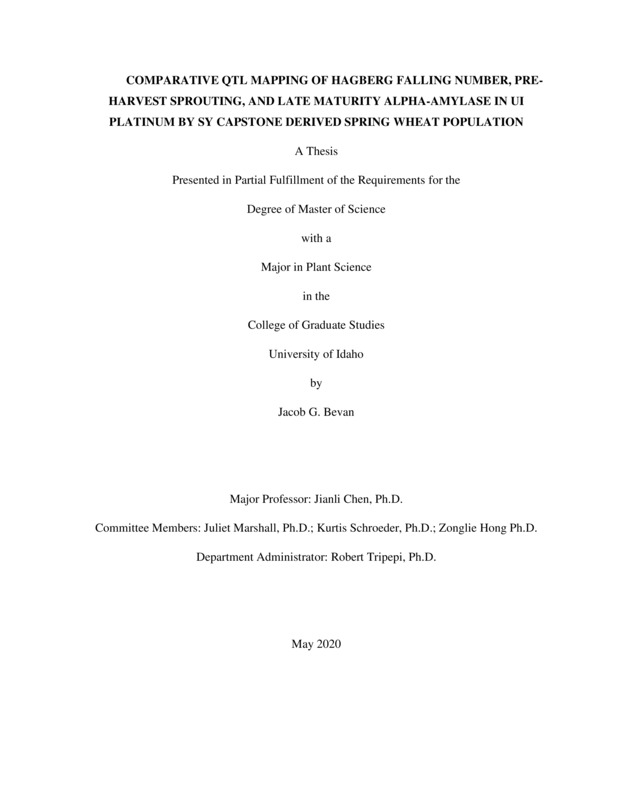COMPARATIVE QTL MAPPING OF HAGBERG FALLING NUMBER, PRE-HARVEST SPROUTING, AND LATE MATURITY ALPHA-AMYLASE IN UI PLATINUM BY SY CAPSTONE DERIVED POPULATION
Bevan, Jacob R. (2020-03). COMPARATIVE QTL MAPPING OF HAGBERG FALLING NUMBER, PRE-HARVEST SPROUTING, AND LATE MATURITY ALPHA-AMYLASE IN UI PLATINUM BY SY CAPSTONE DERIVED POPULATION. Theses and Dissertations Collection, University of Idaho Library Digital Collections. https://www.lib.uidaho.edu/digital/etd/items/bevan_idaho_0089n_11827.html
- Title:
- COMPARATIVE QTL MAPPING OF HAGBERG FALLING NUMBER, PRE-HARVEST SPROUTING, AND LATE MATURITY ALPHA-AMYLASE IN UI PLATINUM BY SY CAPSTONE DERIVED POPULATION
- Author:
- Bevan, Jacob R
- Date:
- 2020-03
- Keywords:
- Falling Number (FN) Late Maturity Alpha Amylase (LMA) Pre-harvest Sprouting (PHS) QTL
- Program:
- Plant, Soil and Entomological Sciences
- Subject Category:
- Plant sciences
- Abstract:
-
The Hagberg falling number (FN) is an important quality trait in common wheat being used in grain trading business and in end-use quality due to starch damage. Measuring FN can is conducted using flour sample after grain is harvested. Therefore, assessment of FN is very expensive and affected by environments where the grains were produced. Pre-harvest sprouting (PHS) and late maturity α-Amylase (LMA) are the two main sources that cause wheat grain samples with low FN. QTL and tightly linked molecular markers for FN, PHS, and LMA is the best alternative that can be used in early generation selection and improvement of selection efficiency. The present study conducted a comparative QTL mapping for the three related traits in a doubled haploid population derived from two hard white spring wheat cultivars UI Platinum (UIP) and SY Capstone (SYC). FN data from nine trials, PHS data from eight datasets in two experiments, and LMA data from two treatment trials were used in QTL analysis. A total of sixteen QTL for FN were detected on seven chromosome regions and five of them (QFN.UIA-1B-1, QFN.UIA-2B, QFN.UIA-3B-1, QFN.UIA-5A-1, QFN.UIA-7A-1) were detected in three or more data sets, explaining 10 to 34% of phenotypic variation. Nine QTL for PHS were identified in three or more data sets on six chromosome regions, explaining 10 to 25% of phenotypic variation. QTL for LMA were identified on chromosomes 4A (UIP HFN), 5A (UIP HFN), and 7A-1 (SYC HFN). QTL on 5A was associated with all three traits and UIP contributed to higher FN, resistance to PHS and LMA. QTL on 7A-1 was associated with FN and LMA and UIP contributed to lower FN and higher PHS score. QTL on 1B-1 was associated with FN and PHS and UIP contributed to the lower FN and higher PHS score. This study suggests that the three traits may share a little genetic information in common, therefore, selecting one trait may be able to indirectly select other related traits. This study also suggests that resistant lines to FN, PHS, and LMA can be selected through genetic recombination for QTL from the two parents. Compared to the physical map of Chinese Spring, the 5A QTL is the flanking region of Amy 3 gene. This suggests that it is necessary to study the Amy 3 gene in order to understand the genetic control of the three traits assessed in the present study.
- Description:
- masters, M.S., Plant, Soil and Entomological Sciences -- University of Idaho - College of Graduate Studies, 2020-03
- Major Professor:
- Bevan, Jacob G
- Committee:
- Chen, Jianli; Marshall, Juliet; Schroeder, Kurtis; Hong, Zonglie
- Defense Date:
- 2020-03
- Identifier:
- Bevan_idaho_0089N_11827
- Type:
- Text
- Format Original:
- Format:
- application/pdf
- Rights:
- In Copyright - Educational Use Permitted. For more information, please contact University of Idaho Library Special Collections and Archives Department at libspec@uidaho.edu.
- Standardized Rights:
- http://rightsstatements.org/vocab/InC-EDU/1.0/

